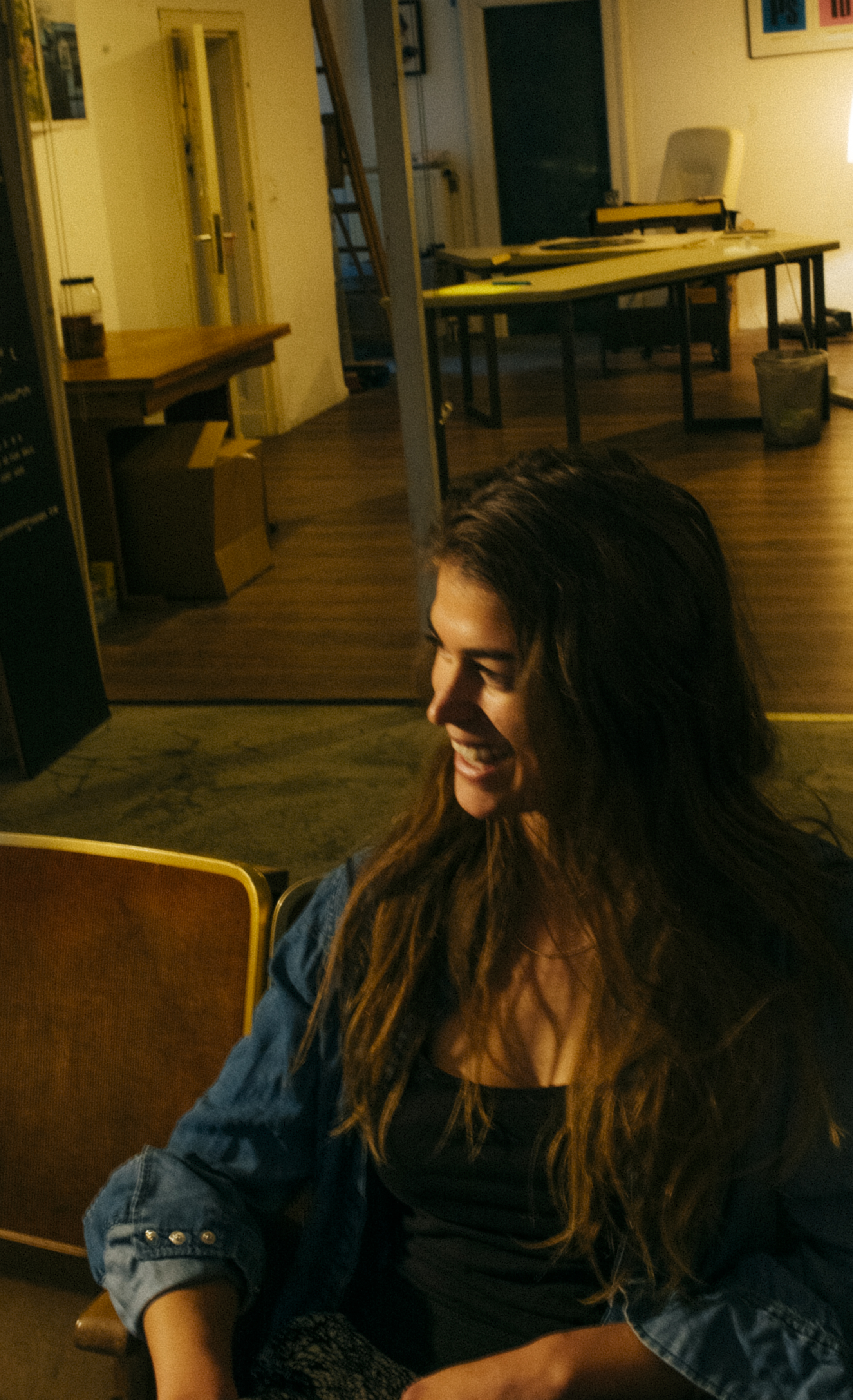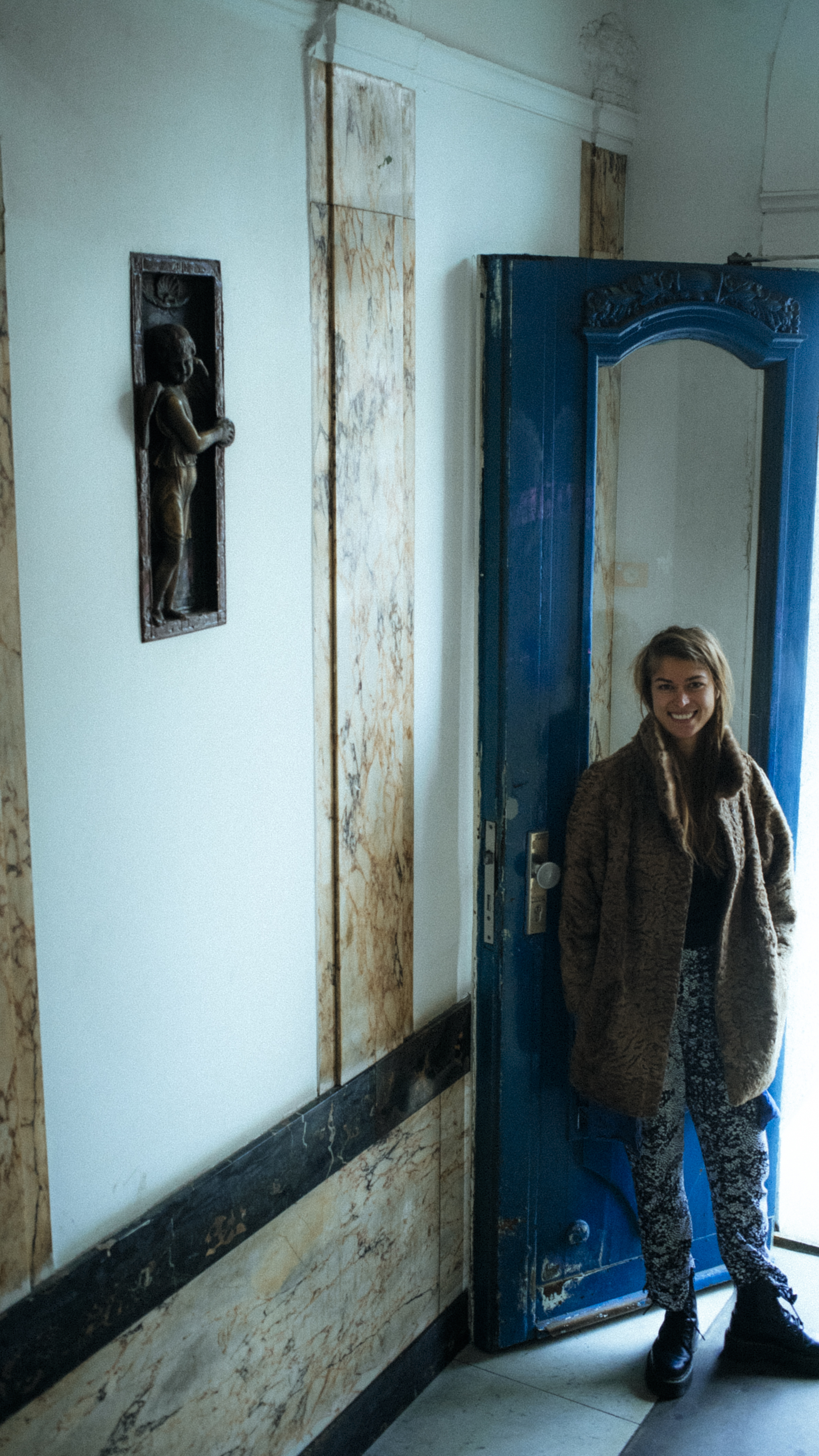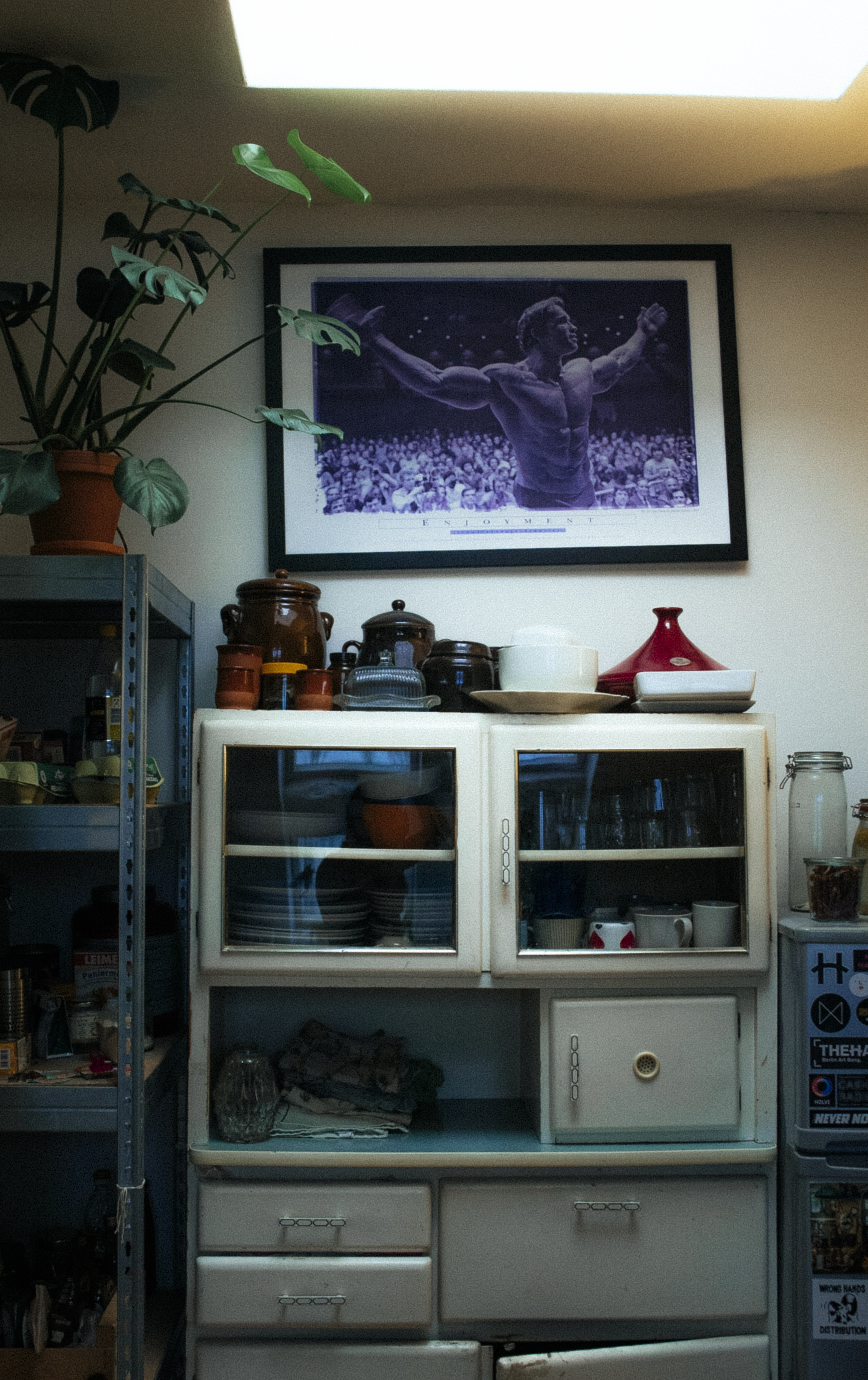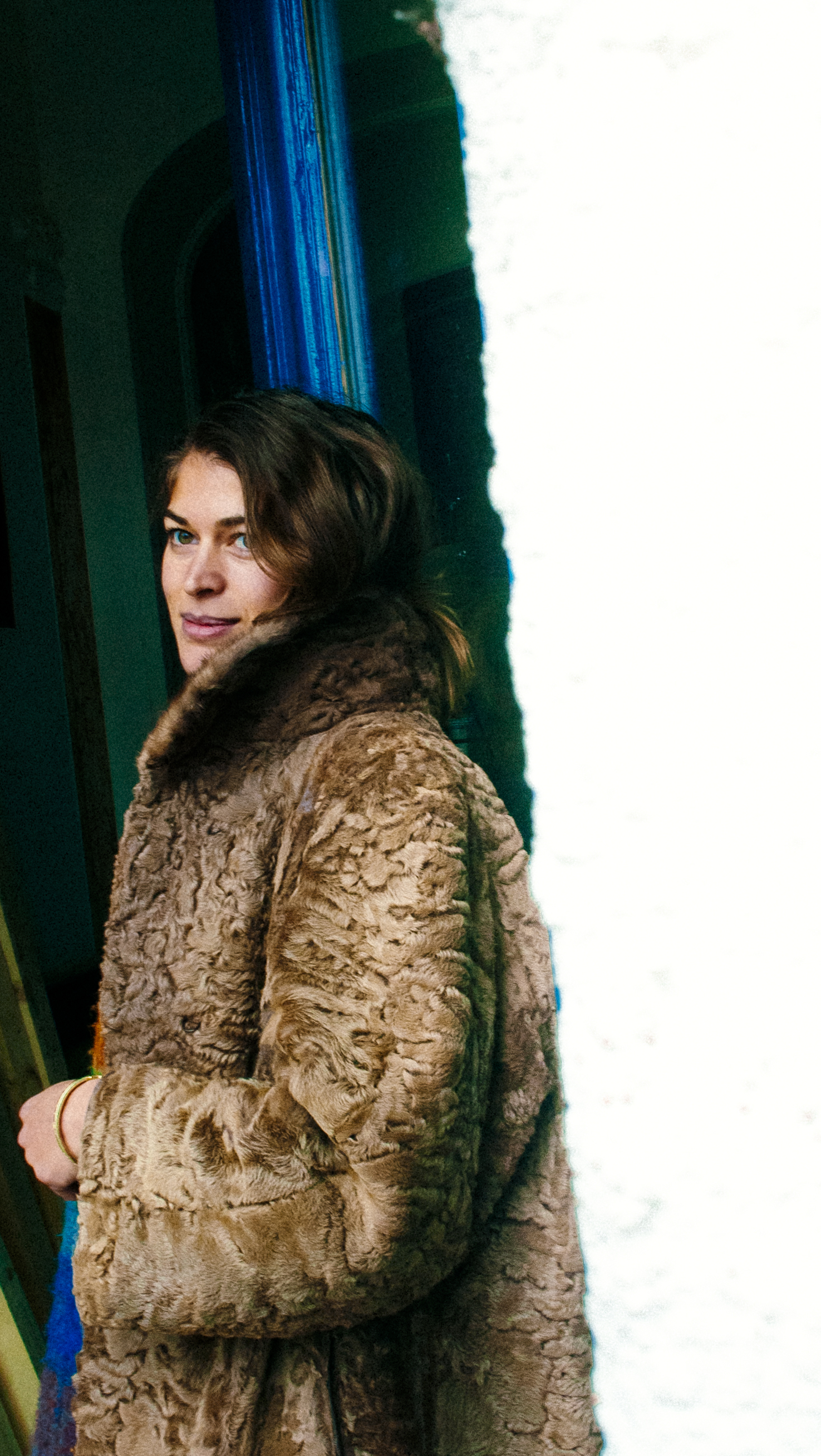Chapter 2
Alexis
—
You might already know Alexis Goertz as Bacteria Girl, Bacteria Barista, Mother Kombucha or Berlin’s Queen of Fermentation. Her personality is as bubbly as an active jar of yeast and she’s one of those people who lights up any room with her bright energy.
Alexis first stepped into the world of fermentation in Mozambique. Her stomach was struggling to cope with all the foods her body was not accustomed to. Locals urged her to place her trust in fermented corn drink, called Maheu, claiming it would help her digestive system acclimatize to the foreign bacteria. Always open to trying new things, she took their advice. Eight years later, she’s travelled to 41 countries and her gut’s microbiome is the core of her calling. Chance brought her to Berlin in 2014, where she started out as an artist before shifting her focus to sharing her bacteria cultures and knowledge with the community. In 2018, her business Edible Alchemy is growing faster than you can say kombucha hotel*.
I attended one of Alexis’s sourdough bread workshops in November 2017 and was immediately intrigued by her enthusiasm for the tango between body, mind and bacteria. Six weeks later, I found myself sipping sage tea in her workspace asking questions about her family, favourite foods, and fearless fermentation. We later moved the conversation upstairs to her kitchen, so she could get to work on shredding several kilos of cabbage for a fresh batch of sauerkraut. I was delighted to discover that Alexis’s fridge contains jars upon jars of handmade, probiotic goodness, and her room looks like it fell out of a bohemian Pinterest board. A marvelous Saturday spent chatting about art, travels, and life as a bacteria dealer.

You were raised in Winnipeg, Canada. How would you describe your relationship to food before you started traveling?
I was always interested in food, but I grew up on white bread, baloney, square cheese, cheese whizz—everything pretty much mass-produced, industrial, and pasturized. Then, my sister, who is nine years older than me, turned vegetarian and she inspired me to look at food in a broader perspective. “What’s in the meat we’re eating? Antibiotics? What’s not good for you?"As you travel, you come to realize that food is survival. You also get introduced the amazing tastes that other countries have to offer. When I was in Thailand, I was very young and I had no plan. I just went there and loved all the incredible flavors. Incidentally, most of them were products of fermentation. Take fish sauce, for example. That crazy, strong, pungent taste is from fermentation.
How does your mother feel about the bacterial world you’ve built for yourself so far away from home?
I think she’s still trying to understand it. I moved to Berlin when I was 23 years old. Whenever people ask her what I’m doing here she says, “I don’t know. She’s some kind of bacteria dealer.” It’s true, I am a bacteria dealer. I send her articles like this one to help her understand more. She’s definitely appreciating what I do, but I don’t think it’s a part of her lifestyle. When I’m home in Canada I always make sauerkraut and bread. Everyone loves it. I mean, fresh bread from the oven? Can’t lose.

So how did you end up in Berlin?
It’s one of those stories where a city really captures you. I wanted to live in Europe for a little time, a year maybe. I speak Spanish, French, and Portuguese, so I thought of France, Spain, or Portugal. Those visas weren’t easy to get, but Germany said, "Here’s free visa for one year. Do what you want: work or play." I was traveling the world at the time. I went from Indonesia to Paris to London to Brussels and then hitchhiked to Berlin. I thought it would be my home for the next year. Until the visa runs out and then I'd go home, maybe live in Vietnam, or maybe live back in Mozambique. I haven’t left since and it’s been almost four years. It can handle my energy. I love it.
What was your first job here?
I came as a print maker and I was making art at Künstlerhaus Bethanien which has a print studio in the basement. I was selling art in galleries and on the street from a cart that we made from a bicycle, and also working as an English kindergarten teacher. I had already started Edible Alchemy in Winnipeg, which is why I already owned a bunch of bacteria.
I thought that maybe people here would be interested in them too, so I set up the bacteria beside my art. The art, you’re just putting your blood, your sweat, your tears, and your time into. Meanwhile, the bacteria are growing on their own and you're simply putting them in old pickle jars. Everyone is looking at the art going, "Hmmmm I’m not sure. It looks a little bit too pricey for me. I don’t know if I can see that in my house.” And then they look at the bacteria, which looks disgusting, and they go "OHHHH what is THAT?” Then you tell them and they take three. I quickly came to realize that business is in the bacteria.

So how does your art weave into Edible Alchemy?
My art life doesn’t struggle or suffer. I just combine it with the work that I do now. I started by making these little self-published, informational magazines, which I call zines. Together with my business partner, Natalie, I did screen prints for the covers and collaged the insides—all very handmade. Then we started making posters and other things similar to that. It’s a really fun outlet.
I also did some performance in my earlier years and now that can come out and I use it in workshops. There’s the Microbial Circus, a branch of Edible Alchemy, which happens once a year. Basically, Natalie and I come together in Europe and do a tour. We meet up with kimchi specialists, sake samurais, miso gurus and all these other experts. We share our skills, they share theirs, we trade bacteria, and host workshops—all in the form of a circus. It’s more of a performance-based edutainment. Sometimes it’s individuals, sometimes we teach at schools. It depends who invited us. Some years ago the Microbial Circus went to Iceland, Croatia, the Netherlands, and all around Germany. This year, in March, we are going to Barcelona, London, and Berlin.


Be it on stage or online, you put yourself out there to the world every single day. Why do you do it?
I live for people. I love being with people and I love the feeling just before going on stage. That slight stage fright, nerves are tingling. I kind of get addicted to it. I think that’s why I enjoy workshops so much. As soon as the first person walks in the door, you’re on and you forget about everything else that’s going on.
Webinars and workshops are completely different, because with webinars you don’t have that face to face interaction. Even if you have 150 people in the audience, you don’t see their faces and their reactions. Them saying, “I get it!" or “What? I don’t understand.” As soon as I see that face I want to answer their questions or their body language. If I was a hermit in my own world, which wouldn’t be a bad thing it’s just not who I am, I would just be home tinkering and fermenting. Either that or starting up a sauerkraut business and stomping kraut all night. But I love people and that’s who I do this for. In the end, my art, my food, it’s for people.




What have you learned about yourself in the process of becoming a business owner?
I’ve learned that I can bee a workaholic, in a good way. I enjoy what I do so much, I could really work 24 hours a day on projects. There are so many things to do. Right now I’m kind of doing this single-handedly in Berlin. This means advertisement, website updates, performing workshops, setting up, cleaning. Every aspect. As a result, I know the entire background and every little facet of my business.
I’ve been approached by investors in the past, but I’ve also been approached by people who would probably want to change it in ways that I don’t want. I believe that, for now, I should keep the power to propel it in the direction that I want myself rather than let big guys, like Nestle and Unilever, change the direction. I don’t want to sell my soul to the devil. So right now I feel like doing this singlehandedly. But it’s also not singlehandedly because of the community aspect. I don’t want to lose that.
Being an entrepreneur definitely has its downsides. Downsides meaning: you are in control of everything and if it’s not going well you better recognize where that is. You have to be accountable for everything.

What is food to you?
Food is your medicine, in a way—your energy, your livelihood, the way that it can balance your insides, which in turn, actually balances your outsides. The microbiome is where all that food is going. If you’re putting the right things in there, you're going to notice it on your skin, you’re going to notice it in your mind, your physical abilities, your energy levels.
I’m all about diversity. I have cake in my bag, which I bought at the bakery. It’s not gluten-free, lactose-free, or sugar-free. It’s loaded with those things. Our gut and our brain are both muscles. Just like our legs, our arms, and our hearts. And we need to work them and use them in the right ways. If we’re constantly putting in different things into them they’re working. It’s like doing the same sudoku every day. You’re not getting smarter you’re getting faster, which is fine, but you’re not really working that muscle anymore. You're memorizing, but your’e not training it to be able to combat different possibilities.
If you're putting different things in your gut all the time, your gut is going to be strong and be able to combat when you eat something strange in another country, or even at a friend’s house. If you’re eating oatmeal every day—oatmeal, oatmeal, oatmeal—and then a friend invites you over for pancakes, your gut says, “WOAH, what’s this? I don’t understand!” And that example isn’t even that far off.
Food is also intriguing. When I was in Lithuania, I would go to the markets and have fermented everything—garlic, pickles, apples… Tasting these flavors was completely new to me. And then it changes from region to region and food becomes an exploration.
What is the most surprising flavor you ever encountered?
Hákarl, a fermented shark from Iceland. It doesn’t leave the country, because it’s illegal to take on a plane or bus. It’s like trying the bluest cheese rind that you shouldn’t eat at the same time as gasoline, while dunking your head in a pale of fresh horse urine. Non-fermented shark meat is so full of ammonia that you would actually die eating it, so they have to process it to lower the ammonia levels. But even then, while your’e eating it your eyes are still watering because of the ammonia levels and it still smells of, or still feels like, horse piss. I liked it, I’ve had it a couple of times.
Speaking of strange foods, several years back you did a presentation with a fermented insect specialist. Care to elaborate?
We got together with other crazy food trenders and had an event themed around the connection between our brain and food. It included our preconceptions of food and this insect specialist was talking about the new trend of bugs, as well as the psychology of flavors and memory. This was two years ago, and I still feel like bugs have not really reached their highest point yet, but they’re coming. Just the other week I meet a woman in Potsdam who is doing mealworm everything—mealworm noodles, mealworm cookies…it’s coming.


How would you describe the role of food and fermentation in culture?
Years and years and years of working with the same materials, and you discover many interesting ways of using it. If you were just given flour, for example, you’re going to make chapati, you’re going to make naan bread, you’re going to start discovering that there’s something called sourdough. And you begin to discover these things because you’re working with the same material all the time.
Sauerkraut came from people having a lot at the end of the season and not knowing what to do with it. With winter approaching they needed to preserve it. So it didn’t come from a health aspect, but rather preservation. It resulted in this great taste and so people started making more. Or turning grapes into wine. People recognized the great taste, recognized the effect on the body, the effect of being drunk. That created a culture. It’s intentional proliferation. It’s people taking something and manipulating it in an intentional way to taste the way that it should. In France they have these cheese caves and they intentionally keep the environment the same to keep these results, such as Époisse of Saint-Félicien. You can put the same cows milk in five different caves and get different results. This is a culture. This is part of the villages’ and towns’ tastes. And a lot of people are very proud to present their tastes, their grandma’s tastes.
The whole fusion movement that is happening at the moment is because of the spices that are being traded. Right now we can get everything here in Berlin. I’m currently playing around with different fermentation techniques that I’ve never seen before and I’m getting great results. Who knows, maybe I’ll patent them in the future, when I’m ready to have production.
As an edible alchemist, what would you say is the biggest secret of the alchemy world?
I would say rebalancing your microbiome. Getting your microbiome on track is the secret to your mood, the secret to good skin, the secret to your energy. And it’s not even really a secret, it’s actually being uncovered now with all kinds of scientific research. They are discovering that the microbiome can even correct people’s diseases. Millions of dollars are being poured into these projects and so I’d say: Start now! Start with living foods. The secret is being revealed daily.
Supplements are not even FDA approved. These are all freeze-dried powdered probiotics and the box is selling you trillions of bacteria in every pill and I’m asking them “OK, but which varieties? Which strains?” Sure the box says lacto bifidus and acidophilus, but which strains? Because a lot of those don’t even reach our intestines. They’re just dying before they even get there. Besides, compared to sauerkraut, you’re missing the fiber, you’re missing the water, you’re missing the vitamins. It’s not a very holistic approach.
If you look at our forefathers, they have been doing it [fermentation] for years and years. So the secret is fermented foods and drinks, but we can’t find them out there. This is why I’m doing this business—to spread that knowledge and hopefully get more things into stores for the people that don’t want make it themselves, but are ready to take living food off the shelves and consume.

Tell me a little bit about the things that excited you.
The whole topic of culture is exciting to me. Culture meaning people, meaning their mannerisms, meaning languages, meaning the food. Food is also cultured. And there’s life in culture. You could say culture dies, or culture can die, but there’s always something developing. It’s not like everything is wiped out. For me it means there’s always something to discover.
It’s also interesting how much body language works if you don’t speak. I was recently in Lithuania and it was still possible to do things and communicate through body language. That fascinates me completely.
And learning. There really is something to learn from everyone. I know that’s kind of a cliché thing to say, but there definitely is. If you don’t see it, either you’re not looking hard enough, or they’re not willing to share with you. If that’s the case, then maybe you have to change the way you’re approaching them to get them to open up.

Who inspires you?
First, I would definitely give a shout to Natalie, because she’s also a world traveller and she brought me to this world of fermentation. Best-case scenario, we talk once a week on Skype, just bouncing ideas off each other, sharing our experiences.
I would also say the old Omas who keep the cultures alive. These older generations of people are some of the most inspiring because they’ve held on to culture for so long—especially when they’re in their 70s, 80s, 90s. Most of the time, we don’t even speak the same language, but again, we’re speaking this body language. In Japan I spoke with Shimoyo. She’s this old lady who showed me with her hands how to make this cheese, how to work with shiso leaf, how to make her pickles, and how to do the green tea ceremony. She spoke Japanese the whole time and, even though I don’t speak Japanese, her language was so clear that I felt like I understood her and she also felt like she understood me.
And of course, the other gurus out there that are doing things. Right now the internet is where people are becoming icons around the world. But I still always find it most fascinating to discover these humble people that live in teeny, tiny villages and have never even used a computer before. And then in their village they’re like a celebrity. You ask someone “Hey, I’m looking for this particular yogurt culture. Do you know who has this?” And then you are lead down these paths and come to this strange, little hut and people are like, “This lady has it and she doesn’t speak English, but she speaks Magyar so go ahead.” I like making relationships that way. To me that’s the most exciting part.
Thank you Alexis.

After the interview, I asked Alexis if she would like share something personal with her readers. She described her own life as “a bit of an open book.” Ever since she was eight years old, she has recorded her thoughts, ideas, and memories in diaries. Privacy aside, she spends every single day putting herself and her work out there to the world. Sharing Edible Alchemy means sharing a big part of herself, in workshops, webinars, in her newsletters, in the media, and more. I feel privileged that she took the time out of her busy week to share a little window into her life and project with you and with me.
Interview: Maia Frazier
Video & images: Daniel Eceolaza